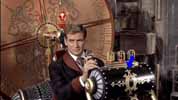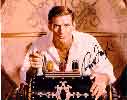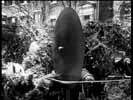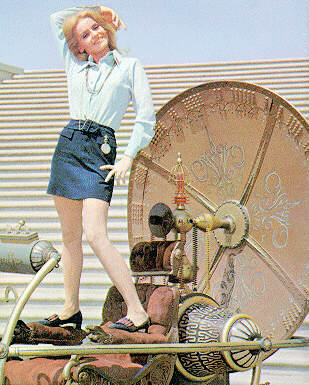


Itsy
bitsy, teeny weeny, little goofs
When
George departures from the year 1917 the decorative golden dot on the
panel is still there, but when he arrives in the Blitz in 1940 the dot
has almost vanished... and if you see on the signed picture of Rod Taylor
sitting in the machine, it is considerably smaller than in the year
1917.
If
you click on the picture from Time Machine: The Journey Back
below, you can see that one peg in quadrant II on the dish is missing.
Neither Rod nor the film crew did notice that...


Imaginary
switches
When George first sits in the Time Machine he presses three imaginary
switches which don't exist on the panel!
Peter Montagna
from USA, spotted this one!

Verbal
goof #1 in Time Machine: The Journey Back
Rod Taylor says
that there is 365 knobs/pegs on the dish - the same amount as days in
a year, make sense -- but I have counted them. They are only 348! Somehow
17 pegs are missing!
The pegs are grouped in four on the dish like this:
Quadrant I: 5-3-6-2-5-1
Quadrant II: 5-2-2-3-1-4-4
Quadrant III: 1-6-2-5-2-6-1
Quadrant IV: 1-4-2-3-1-4-5-1
Sum of pegs on
quadrant I: 4 X 22 = 88
Sum of pegs on quadrant II: 4 X 21 = 84
Sum of pegs on quadrant III: 4 X 23 = 92
Sum of pegs on quadrant IV: 4 X 21 = 84
Total sum of pegs on the dish: 88 + 84 + 92 + 84 = 348
And the most interesting
part of this is that you can't divide 365 with 4! If you want complete
365 pegs on the dish you must put on 17 extra of them wich is 4 X 4
- and one peg will remain left! Where to put a single peg on the dish...
?
And i also have
spotted two little teeny-weeny bonus goofs because of this: Chris Perrotta
has goofed on his nice 3D-computer model of the Time Machine which is
in the Don & Mary Colemans Time Machine site! Look at quadrant IV
and compare it with the quadrant in the film The Time Machine.
Quadrant IV of
Perrottas 3D-computer model dish: 1-4-2-3-2-4-4-1
And the Lunar Model's
Time Machine got a similar goof on the same quadrant:
Quadrant IV of
Lunar Time Machine Model dish: 5-2-3-1-4-5-1
But I must admit
that both of them got the amount of pegs right...

Verbal
goof #2 in Time Machine: The Journey Back
Rod Taylor tells
about the "rococo, centuries enduring Time Machine", but the
Time Machine is not in rococo style! This style was modern in
the middle of the 18:th century, ca 150 years before the opening
story in the film The Time Machine. The Time Machine isn't either
in neo-rococo style which was modern in the 1860:s. The right answer
is that the Time Machine is built in neo-renaissance style with a little
dash of jugend, especially in the chair. These styles were modern in
1899. The acantus ornaments on the dish and the cartouche on the console
is typical for the neo-renaissance style, also the black-and-white geometric
ornaments on the generator pods. And all of the ornaments are symmetric!
Rococo style never uses symmetric ornaments, hence the name rococo:
a rocaille is French for an assymetric shell-shape and I can't
find any of them on the Time Machine.


Special
trivia about the rear side of the Time Machine
Since June 2004
I thought I have spotted something extraordinary: I have believed that
the Time Machine had ornaments on the backside of the dish. This publicity
still shows the Time Machine standing in the garden of George Wells's
house and on the rim of the dish is barely visible regularly placed
spots. I thought they were ornaments similar to them on the frontside
which surrounds the four large acanthus ornaments. I also thought these
ornaments were gone now, due to that Bob Burns renovated the movie prop
in 1974-76, or -- more possible -- that the ornaments were overpainted
already in 1959 when (I thought) the special effects crew Projects
Unlimited reinforced the dish preventing it from more warping. The
picture above and the information here is to be seen in the documentary
film Time Machine: The journey Back and you can also see the
backside of the dish in the film The Time Machine when George
arrives in the garden from year 802701.
Then
in May 24, 2006, I got a comment from Don
Coleman:
The ornaments you see on the back of the dish are only the nail/brad
heads which are holding on the front panels to the dish. When I was
at the auction there was nothing but the nail heads on the back, thus
I didn't see any need to photograph the rear of the dish. The supports
on the back were added after Bob
Burns acquired the machine, (*see
correction below) not by Project Unlimited. Project had
nothing to do with the full size machine. It was finished before Project
got onboard the film, this is per Wah Chang.
And
in November 1, 2007, I got a correction from Don
Coleman to the comment above:
I have since discovered that the supports where on the dish when Bob
Burns acquired the machine. They must have been added by the person
who bought the machine at the MGM auction.


